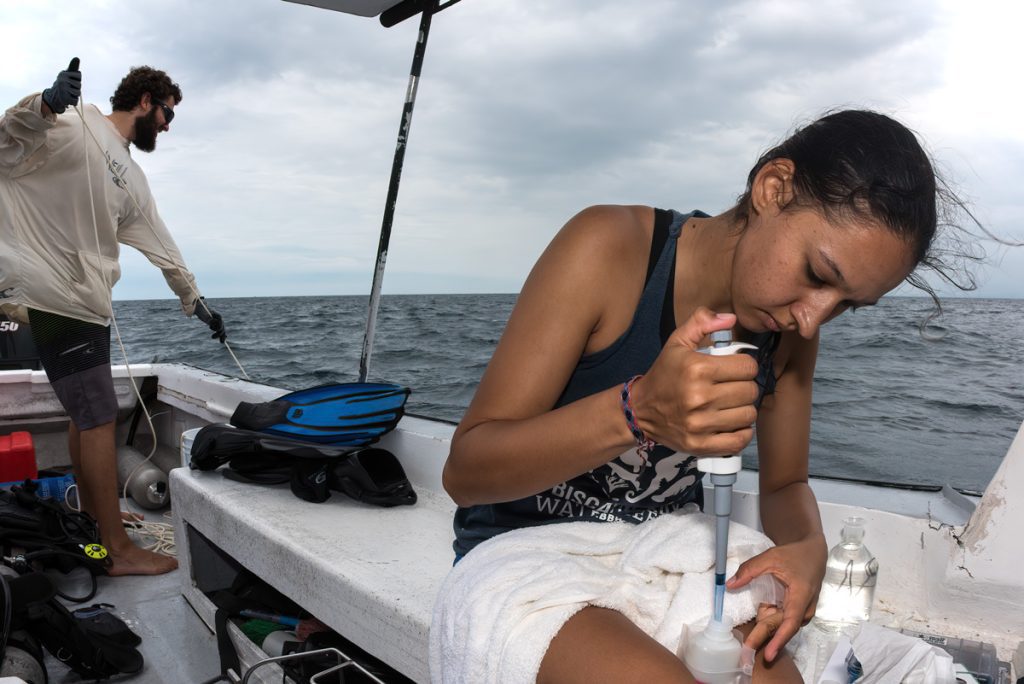A heat-tolerant algae found in some tropical Pacific corals can make reefs more resilient to heatwave events, according to an exciting new discovery reported in the Proceedings of the National Academy of Sciences. Researchers with University of Miami’s Cooperative Institute for Marine and Atmospheric Studies (UM-CIMAS) and NOAA’s Atlantic Oceanographic and Meteorological Laboratory (AOML) examined four decades of temperature, coral cover, bleaching, mortality data from three mass bleaching events, and symbiont community data from the last two. Scientists found that a symbiont algae helped corals better tolerate heat stress, increasing their resilience to warming ocean temperatures.
Global warming is causing the loss of coral reefs worldwide, as a result of heat-induced coral bleaching and mortality. However, some coral reefs exposed to temperature-induced bleaching develop tolerance to subsequent events, possibly due to changes in their symbiotic algae communities. Over the past 40 years, scientists from the University of Miami, NOAA, and partners have been monitoring reefs in the eastern tropical Pacific region, culminating in an interesting discovery.

Credit: Sean Mattson/STR
It became clear that reefs in this region were less susceptible to heat stress following the 1982-83 El Niño event, one which caused catastrophic mortality. However, during the more recent El Niño events of 1997-98 and 2015-16, negative impacts on coral cover were relatively mild. Using sea surface temperature data, researchers found that the heat stress levels that the corals experienced during the three strong heatwaves in 1982-83, 1997-98 and 2015-16 were similar and therefore could not explain the lower coral mortality in the later events. This was a major discovery and it prompted scientists to wonder what changed between the first and second El Niño events?
To assess how different coral species responded to all three heat stress events, researchers collected coral bleaching and mortality data using health assessments of individual coral colonies before and during the heatwaves. Scientists discovered that the most important and a dominant reef building coral in the region, Pocillopora, was among the most heat-susceptible corals during the 1982-83 El Niño, but among the most resistant corals during the 1997-98 and 2015-16 heatwaves.

Credit: Viktor Brandtneris
To learn more about why this coral genus was more resistant to heat stress, tissue samples were collected from tagged coral colonies before and after the last two heatwaves. DNA analyses were used to study the types of symbiotic algae hosted in these corals. This analysis showed that one of two Pocillopora coral species had increased thermal tolerant algal symbionts (Durusdinium glynnii) following the latest heat stress event in 2015-16. This specific lineage of Pocillopora coral experienced less bleaching and less overall mortality compared to the other lineage which did not acquire Durusdinium glynnii.
Climate change projections from AOML scientist Ruben van Hooidonk, PhD, were used to anticipate the amount of heat stress these reefs will experience in the coming decades. Using these projections, lead study scientist Ana Palacio-Castro, PhD, determined that some coral reefs in the eastern tropical Pacific could retain high coral cover through the 2060s. However, Palacio-Castro adds,
“The timeframe from now until the 2060s acts as a ‘buffer’ period where steps must be taken to reduce global emissions and improve our understanding of the climate change system. Without any changes, these reefs will experience entirely new levels of heat stress they may not be equipped to tolerate.”

Credit: Sean Mattson/STRI
The results of this study show a mechanism by which some reefs may be more resilient to ocean warming than previously thought. The accessibility to four decades of coral reef monitoring data provided researchers with the information necessary to make this groundbreaking discovery. This study demonstrates the importance of monitoring coral reef ecosystems over time and how the data can help in answering some of the most complex questions scientists have about the marine environment. This research provides a glimmer of hope for the reefs of the eastern tropical Pacific, stimulating continued commitment to reef conservation and climate action.
– –
The study, titled “Increased dominance of heat-tolerant symbionts creates resilient coral reefs in near-term ocean warming,” was published on Feb.13, 2023, in the journal PNAS. The study’s authors include: Ana M. Palacio-Castro, University of Miami Rosenstiel School of Marine, Atmospheric, and Earth Science, Cooperative Institute for Marine and Atmospheric Studies and NOAA Atlantic Oceanographic and Meteorological Laboratory; Andrew C. Baker, Grace A. Snyder and Peter W. Glynn, University of Miami Rosenstiel School; Tyler B. Smith and Viktor Brandtneris, Center for Marine and Environmental Studies, University of the Virgin Islands; Ruben van Hooidonk, Cooperative Institute for Marine and Atmospheric Studies and NOAA Atlantic Oceanographic and Meteorological Laboratory; Juan L. Maté, Smithsonian Tropical Research Institute; Derek Manzello, Coral Reef Watch, NOAA and Peggy Fong, University of California Los Angeles.
